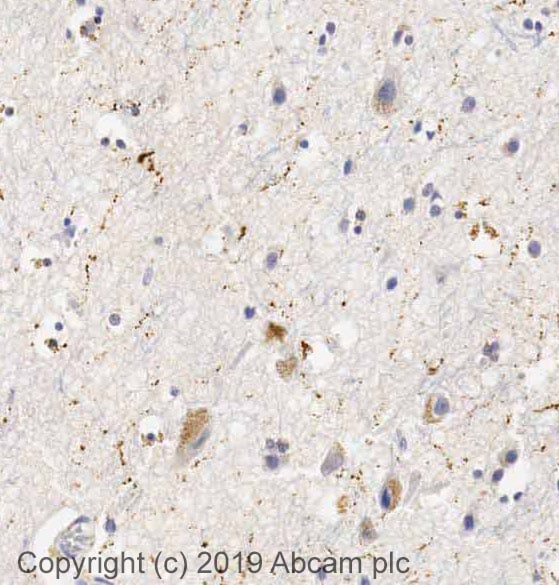Anti-Neuropeptide Y antibody (ab30914)
Key features and details
- Rabbit polyclonal to Neuropeptide Y
- Suitable for: IHC-P
- Reacts with: Human
- Isotype: IgG
Overview
-
Product name
Anti-Neuropeptide Y antibody
See all Neuropeptide Y primary antibodies -
Description
Rabbit polyclonal to Neuropeptide Y -
Host species
Rabbit -
Tested Applications & Species
See all applications and species dataApplication Species IHC-P Human -
Immunogen
Synthetic peptide corresponding to Pig Neuropeptide Y aa 1 to the C-terminus conjugated to keyhole limpet haemocyanin.
(Peptide available asab32971) -
General notes
The Life Science industry has been in the grips of a reproducibility crisis for a number of years. Abcam is leading the way in addressing the problem with our range of recombinant monoclonal antibodies and knockout edited cell lines for gold-standard validation.
One factor contributing to the crisis is the use of antibodies that are not suitable. This can lead to misleading results and the use of incorrect data informing project assumptions and direction. To help address this challenge, we have introduced an application and species grid on our primary antibody datasheets to make it easy to simplify identification of the right antibody for your needs.
Learn more here.
Images
-
 Immunohistochemistry (Formalin/PFA-fixed paraffin-embedded sections) - Anti-Neuropeptide Y antibody (ab30914) This image is courtesy of an abreview submitted by Carl Hobbs, King's College London, United Kingdom
Immunohistochemistry (Formalin/PFA-fixed paraffin-embedded sections) - Anti-Neuropeptide Y antibody (ab30914) This image is courtesy of an abreview submitted by Carl Hobbs, King's College London, United KingdomImmunohistochemistical detection of Neuropeptide Y using ab30914 on formaldehyde-fixed paraffin-embedded rat brain sections. The image shows NPY staining in the cerebellum and frontal cortex of the rat brain. Formaldehyde antigen retrieval step: heat mediated in cittric acid ph6 buffer. Blocking step: 1% BSA for 10 mins at room temperature. ab30914 incubated at 1/1000 for 2 hours in TBS/BSA/azide. Secondary Antibody: anti-rabbit IgG conjugated to biotin (1/200)
-
 Immunohistochemistry (Formalin/PFA-fixed paraffin-embedded sections) - Anti-Neuropeptide Y antibody (ab30914) This image is courtesy of an abreview submitted by Carl Hobbs, King's College London, United Kingdom
Immunohistochemistry (Formalin/PFA-fixed paraffin-embedded sections) - Anti-Neuropeptide Y antibody (ab30914) This image is courtesy of an abreview submitted by Carl Hobbs, King's College London, United KingdomImmunohistochemistical detection of Neuropeptide Y antibody (ab30914) on formaldehyde fixed paraffin-embedded human foetal wall sectionsAntigen retrieval step: Heat mediated. Buffer: Citric acid pH6. Permeabilization: None. Blocking step: 1% BSA for 10 mins at 21°C. Primary antibody incubated at 1/1500 for 2 hours at 21°C in TBS/BSA/azide. Abcam's EXPOSE detection kit was used: ab80436. NB: In the submitted image arrowheads indicate positive features: red for ganglion cells in the Submucosa (Meissner's plexus), green for ganglion cells in the Muscularis externa (Auerbach's plexus). There is also a diffuse fine positivity throughout the smooth muscle cells of the externa.
-
 Immunohistochemistry (Formalin/PFA-fixed paraffin-embedded sections) - Anti-Neuropeptide Y antibody (ab30914)
Immunohistochemistry (Formalin/PFA-fixed paraffin-embedded sections) - Anti-Neuropeptide Y antibody (ab30914)IHC image of Neuropeptide Y antibody staining in a section of formalin-fixed paraffin-embedded human cerebral cortex* tissue performed on a Leica BONDTM system using the standard protocol. The section was pre-treated using heat mediated antigen retrieval with sodium citrate buffer (pH6, epitope retrieval solution 1) for 20mins. The section was then incubated with ab30914, 1ug/ml, for 15 mins at room temperature and detected using an HRP conjugated compact polymer system. DAB was used as the chromogen. The section was then counterstained with haematoxylin and mounted with DPX.
For other IHC staining systems (automated and non-automated) customers should optimize variable parameters such as antigen retrieval conditions, primary antibody concentration and antibody incubation times.
*Tissue obtained from the Human Research Tissue Bank, supported by the NIHR Cambridge Biomedical Research Centre















